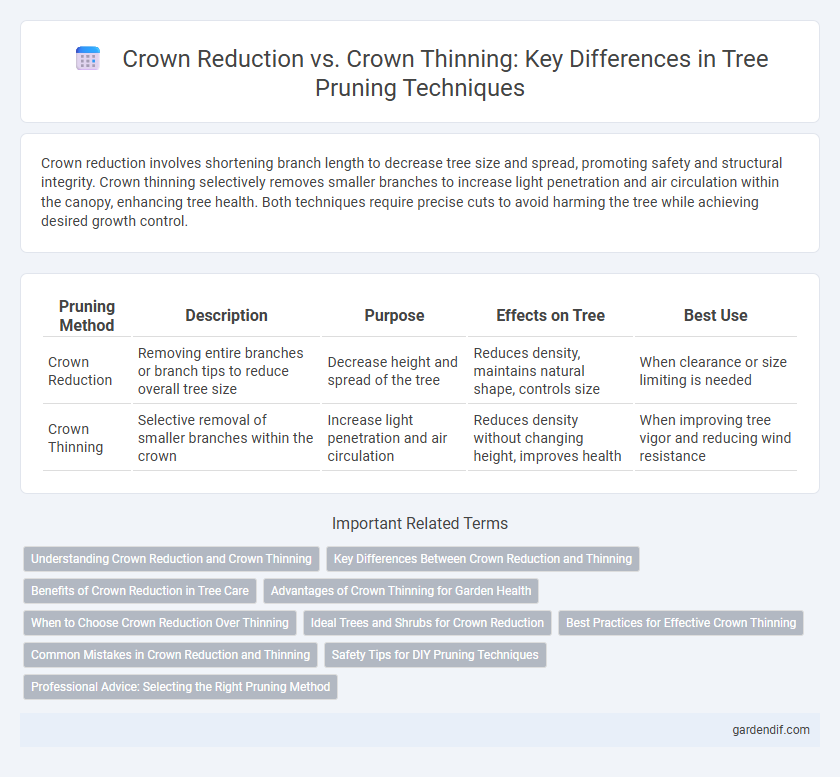
Crown reduction vs Crown thinning Illustration
Crown reduction involves shortening branch length to decrease tree size and spread, promoting safety and structural integrity. Crown thinning selectively removes smaller branches to increase light penetration and air circulation within the canopy, enhancing tree health. Both techniques require precise cuts to avoid harming the tree while achieving desired growth control.
Table of Comparison
| Pruning Method | Description | Purpose | Effects on Tree | Best Use |
|---|---|---|---|---|
| Crown Reduction | Removing entire branches or branch tips to reduce overall tree size | Decrease height and spread of the tree | Reduces density, maintains natural shape, controls size | When clearance or size limiting is needed |
| Crown Thinning | Selective removal of smaller branches within the crown | Increase light penetration and air circulation | Reduces density without changing height, improves health | When improving tree vigor and reducing wind resistance |
Understanding Crown Reduction and Crown Thinning
Crown reduction involves selectively removing branches to reduce the overall size of the tree while maintaining its natural shape and structural integrity. Crown thinning targets the inner branches, strategically removing smaller diameter limbs to increase light penetration and air circulation without significantly altering the tree's height or width. Both techniques improve tree health by reducing wind resistance and promoting balanced growth, but crown reduction is more suitable for size control, whereas thinning enhances light and air flow.
Key Differences Between Crown Reduction and Thinning
Crown reduction decreases the overall size of a tree by cutting back branches to lateral buds or branches, effectively reducing height and spread to maintain structural integrity and prevent hazards. Crown thinning removes selected smaller branches throughout the canopy to increase light penetration and air circulation without significantly changing the tree's size or shape. While crown reduction focuses on size management and safety, crown thinning prioritizes improving tree health and aesthetics by reducing density.
Benefits of Crown Reduction in Tree Care
Crown reduction helps manage tree size effectively, reducing wind resistance and minimizing limb breakage risks during storms. This pruning technique promotes structural strength by selectively removing longer branches, which improves light penetration and air circulation within the canopy. Enhanced tree health and safety are direct benefits, preventing property damage and extending the tree's lifespan.
Advantages of Crown Thinning for Garden Health
Crown thinning improves garden health by increasing air circulation and allowing more sunlight to penetrate the canopy, which reduces the risk of fungal diseases and promotes photosynthesis. This selective removal of branches minimizes wind resistance, enhancing the tree's structural stability without significantly altering its natural shape. Better light and airflow conditions encourage undergrowth development and support a diverse ecosystem within the garden.
When to Choose Crown Reduction Over Thinning
Choose crown reduction over thinning when the tree's size must be significantly decreased to prevent structural damage or interference with nearby buildings and power lines. Crown reduction effectively reduces overall canopy volume by cutting back branches to lateral buds, maintaining natural shape while minimizing stress. Opt for thinning when the goal is to increase light penetration and airflow without altering the tree's size or silhouette.
Ideal Trees and Shrubs for Crown Reduction
Ideal trees and shrubs for crown reduction include species with strong branch structures and moderate growth rates, such as maples, oaks, and crabapples, which respond well to the controlled size reduction. Crown reduction targets the overall height and spread by cutting back branch tips, making it suitable for managing large-growing specimens that require size limitation without compromising health. Selecting adaptable plants with robust healing capabilities ensures long-term vitality after crown reduction pruning practices.
Best Practices for Effective Crown Thinning
Crown thinning involves selectively removing smaller branches to increase light penetration and air circulation, reducing tree weight without altering its natural shape, which promotes healthier growth and reduces storm damage risks. Best practices for effective crown thinning include targeting inward-growing, crossing, or weak branches, maintaining a balanced crown structure, and ensuring cuts are made close to the branch collar to facilitate proper healing. Avoid excessive thinning, typically removing no more than 20-30% of the foliage in a single session, to prevent stressing the tree and compromising its overall health.
Common Mistakes in Crown Reduction and Thinning
Common mistakes in crown reduction include excessive cutting that stresses the tree and creates large wounds vulnerable to disease, while crown thinning errors often involve removing too many interior branches, impairing the tree's structural integrity and natural shape. Improper timing and poor pruning techniques, such as leaving stubs or cutting too close to the branch collar, exacerbate these issues in both methods. Understanding species-specific responses and using correct tools can prevent these detrimental impacts on tree health and aesthetics.
Safety Tips for DIY Pruning Techniques
Crown reduction involves cutting back large branches to reduce tree size, requiring careful assessment to avoid stress and structural damage, while crown thinning selectively removes smaller branches to increase light penetration and airflow, reducing the risk of disease. For DIY pruning safety, always wear protective gear such as gloves, goggles, and helmets, and use sharp, well-maintained tools to ensure clean cuts and minimize accidents. Avoid pruning during wet conditions to prevent slips and infections, and never climb trees without proper harnesses or ladders to ensure stability.
Professional Advice: Selecting the Right Pruning Method
Professional arborists recommend crown reduction for managing tree size and preventing structural damage, especially in urban settings where clearance is a concern. Crown thinning is advised to increase light penetration and air circulation, improving tree health without significantly altering tree height or shape. Choosing the right pruning method depends on the tree species, location, and desired outcomes, with expert evaluation ensuring optimal growth and safety.
Crown reduction vs Crown thinning Infographic

 gardendif.com
gardendif.com